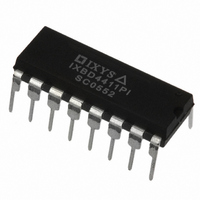IXBD4411PI IXYS, IXBD4411PI Datasheet - Page 10

IXBD4411PI
Manufacturer Part Number
IXBD4411PI
Description
IC HIGH SIDE DRIVER 16DIP
Manufacturer
IXYS
Series
ISOSMART™r
Type
Isolated Half Bridge Driver Chip Setr
Datasheet
1.IXBD4410PI.pdf
(11 pages)
Specifications of IXBD4411PI
Configuration
High-Side
Input Type
Non-Inverting
Delay Time
110ns
Current - Peak
2A
Number Of Configurations
1
Number Of Outputs
1
High Side Voltage - Max (bootstrap)
1200V
Voltage - Supply
10 V ~ 20 V
Operating Temperature
-40°C ~ 85°C
Mounting Type
Through Hole
Package / Case
16-DIP (0.300", 7.62mm)
Product
Half-Bridge Drivers
Rise Time
100 ns
Fall Time
150 ns
Supply Voltage (min)
10 V
Maximum Power Dissipation
600 mW
Maximum Operating Temperature
+ 85 C
Mounting Style
Through Hole
Bridge Type
Half Bridge
Minimum Operating Temperature
- 40 C
Number Of Drivers
1
Output Current
2 A
Lead Free Status / RoHS Status
Lead free / RoHS Compliant
If the MOSFET switched 25 A, the
transient will last as long as (25/500) µs
or 50 ns, which is more than the typical
6 or 7 ns propagations or of a 74HC
series gate.
Fig. 10 illustrates an example layout
problem. The power circuit consists of
three power transistors (MOSFETs in
this example). With the ISOSMART™
gate driver chipset grounded as in
option (b) in Fig. 10, the communication
path from the IXDP630 will operate
without errors. The PC trace induced
voltages are not common with the digital
Fig. 9: Suggested IC Orientation
path, so the input of the gate driver will
not see or respond to them.
Unfortunately, the MOSFET will not
operate properly. The voltage induced
across LS1 when Q1 is turned on, acts
as source degeneration, modifying the
turn-on behavior of the MOSFET. If
LS1= 27 nH, and V
the gate plateau of the MOSFET is 6 V),
the di/dt at turn-on will be regulated by
the driver/MOSFET/LS1 loop to about
200 A/µs; quite a surprise when your
circuit requires 500 A/µs to operate
correctly.
It is possible to make use of this
behavior to create a turn-on or turn-off
di/dt limiter (perhaps to snub the upper
free wheeling diode reverse recovery).
While possible, this is normally not
desirable or practical where two or more
transistors are controlled. Equalizing the
parasitic impedances of three traces
while positioning the transistors next to
their heat sink and meeting UL/VDE
voltage spacings is just too difficult.
Grounding the gate driver as in option
(a) in Fig. 10 solves the MOSFET turn
on problem by eliminating LS1 from the
source feedback loop. Now, unfor-
tunately, the gate driver will oscillate
every time it is turned on or off. As the
IXDP630 output goes "high", the gate
CC
is 15 V (assuming
drive output follows (after its propaga-
tion delay) and the MOSFET starts to
conduct. The voltage transient induced
across LS1 (V = LS1 • di/dt) raises the
local ground (point a) until it exceeds
V
propagation delay) turns the MOSFET
off. Now the MOSFET current falls,
V(LS1) drops, point (a) drops to system
ground (or slightly below), and the driver
detects a "1" at its input. After its
propagation delay, it again turns the
MOSFET on, continuing the oscillation
for one more cycle.
level transformation circuit must be
added, that rejects this common mode
transient. The simplest is a de-coupling
circuit, also illustrated in Fig. 10. The
capacitor voltage on C
constant while the transient voltage is
dropped across R
detects no input transition, eliminating
the oscillation. This circuit does add
significantly to turn-on and turn-off delay
time, and cannot be used if the transient
lasts longer than the allowable delays.
Delay times must be considered in
selection of system dead time.
The most complex (and most effective)
method of eliminating the effects of
transients between grounds is isolation.
Optocouplers and pulse transformers
are the most commonly used isolation
techniques, and work very well in this
case. The IXDP630/631 has been
specifically designed to directly drive a
high speed optocoupler like the Hewlett
Packard HCPL22XX family or the
General Instrument 740L60XX optologic
family. These optos are especially well
suited to motor control and power
Fig. 10: Potential layout problems that create functional problems
To eliminate this problem, a ground
oh
(630) - V
il
and the driver (after its
d
and the driver
d
remains
conversion equipment due to their very
high common mode dv/dt rejection
capabilities.
Transformer Considerations
The transformer is the communication
link and isolation barrier between the
high- and low-side ICs. The high-side
gate and fault signals are transmitted
through the transformer while main-
taining the proper isolation. The
transmitter signal is in the form of a
square wave, but the receiver responds
only to the logic edges. This allows for
much smaller transformer designs,
since a 10 kHz switching frequency
does not require a 10 kHz pulse
transformer.
The recommended transformer for this
ISOSMART™ driver chipset is
fabricated using a very small ferrite
shield bead (see Fig. 11), onto which a
six-turn primary and a two-turn
secondary winding of 36 AWG magnet
wire are made. The two windings are
segment wound to achieve primary-to-
secondary isolation of up to 2500 V~.
The six-turn primaries are connected to
the respective IXBD4410/4411
transmitter outputs and the two-turn
secondaries are connected to their
respective receiver inputs.
© 2004 IXYS All rights reserved
IXBD4410
IXBD4411












